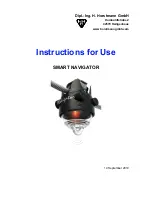
Instructions for Use
Dipl.-Ing. H. Horstmann GmbH
SMART NAVIGATOR
9
2.2.3
F
AULT
I
NDICATION AND
L
INE
M
ONITORING BY
R
ADIO
S
IGNAL
Once the SMART NAVIGATOR identifies fault current above its trip rating threshold, the SMART
NAVIGATOR sends a short range radio message to the SMART RECEIVER. This event based
message contains the status of the overhead line and other system data. Events can also be triggered
other status changes like a loss of current:
Event based reports:
Fault
detection
Momentary vs. permanent fault detection
Low
battery
In addition the SMART NAVIGATOR also monitors parameters of the overhead line. These functions
are provided by a 15 minute communication interval.
Continuous reports:
Routine call every 15 minutes for status updates
Average load current
Ambient
temperature
2.3.
W
IRELESS
C
OMMUNICATION
The SMART NAVIGATOR FCIs communicate with the SMART RECEIVER via low power RF wireless
technology using the world-wide available 2.4GHz ISM (Industrial/Scientific/Medical) frequency band.
The range between the SMART RECEIVER and a SMART NAVIGATOR can extend up to 100ft
(30m).
The SMART CONTROLLER concentrator within a SMART RECEIVER always acts as the short range
radio network master controlling the communication with all the FCIs. Every SMART NAVIGATOR
needs to pass an initial registration procedure to successful register at the SMART CONTROLLER
before any communication can start.
The SMART NAVIGATOR will be the part that initiates radio contact with the SMART CONTROLLER.
2.3.1
P
RIORITY
E
VENTS COMMUNICATE BY EXCEPTION
If a SMART NAVIGATOR detects a priority event such as a fault alarm it will initiate communication
immediately. Therefore the SMART NAVIGATOR will initiate contact with the SMART CONTROLLER
and transmit such events immediately.
2.3.2
R
EPORTS COMMUNICATE BY ROUTINE INTERVAL
Every 15 minutes each SMART NAVIGATOR establishes its communication to the SMART
CONTROLLER to update its analog and status data.


































